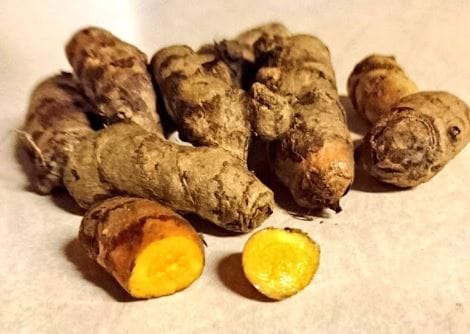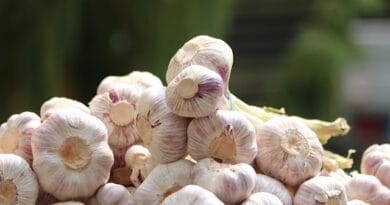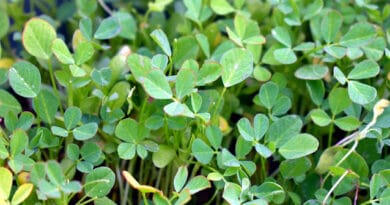Cultivation of Turmeric ; Curcuma longa L
Turmeric, what we use in our houses, is a dried form of the rhizomes of Curcuma longa L, which belongs to the family Zingiberaceae, a native of South Asia, particularly from India. India has a 78% market share of global turmeric production, followed by China (8%), and other countries like Myanmar, Bangladesh, Nigeria, etc. In India, the Major turmeric-producing states are A.P., Tamil Nadu, Odisha, Karnataka, West Bengal, Gujarat, Meghalaya, Maharashtra, and Assam, out of which, Andhra Pradesh alone occupies 38.0% of the area and 58.5% of the total turmeric production in the country.
Climate and Soil Required for Turmeric Cultivation
Turmeric can be grown in various climatic conditions but primarily, it is a crop of tropical conditions and can be grown at minimum sea level to sea level up to 1500 meters above the ground with a yearly rainfall of 1500 mm and a temperature range of 25 – 35 degrees Celsius.
It can be grown in a variety of soils but sandy or clay loam with a pH level of 4.5 to 7.5, which has good drainage and a high organic stratum.)
Varieties of Turmeric ;
| Variety | Duration | Av. Yield of Fresh Rhizome Tones/Ha | Recommended For the Area |
| IISR – Pragati | 180 | 38 | Kerala, Tamil Nadu, Andhra Pradesh, Telangana, Karnataka and Chhattisgarh |
| IISR – Pratibha | 225 | 39 | All Over India |
| Suguna | 190 | 29 | Kerla, AP |
| Suvarna | 200 | 17 | Kerala, Karnataka, AP |
| Kedaram | 210 | 5.28 dry RhizomeT/Ha | Kerala, Karnataka, Maharashtra and North Bengal |
| Prabha | 205 | 37 | All over India. |
| Sudershna | 190 | 28 | Kerala and Andhra Pradesh |
| IISR-Alleppey Supreme | 210 | 5.28 dry RhizomeT/Ha | Kerala (rainfed) Maharashtra, Karnataka and N. Bengal (irrigated) |
Preparation of Land for Turmeric Cultivation ;
Deeply plough the field 3 – 4 times, afterward planking of the field is done, prepare the beds of one meter in width, 30 cm in height, with a convenient length size considering the spacing between the two beds of about 50 cm. In the case of the assured irrigation facilities, the ridges and furrows are prepared, and the planting is done on the top of the ridges in shallow pits
Required Seed material for Turmeric Cultivation;

1) Select healthy and disease-free rhizomes for planting purposes (from the already carefully preserved seed stocks).
2) In case of the unavailability of high-yielding varieties, local seed material can be used to avoid the delay in sowing.
6) Seed rhizomes are treated with mancozeb 0.3% (3 g/L of water) for 30 minutes, shade dried for 3-4 hours, and planted.
7) A seed rate of 2,500 kg of rhizomes is required for planting one hectare of turmeric.
Transplanting of Turmeric ;
The technique of Raising a Single Bud Turmeric Seedling ;
1) Treat the pre-selected rhizome for seed with the chemical mancozeb 0.3% and quinalphos 0.075% for thirty minutes and store it in a safe, ventilated place.
5) Plant the sprouted turmeric buds in Pro-trays and keep them under the shade ( 50% Net)
6) Irrigate the Pro-Trays as per need
7) After 30 – 35 days, the seedling is ready to be transported for transplanting.
Planting of Turmeric Plant;
Required Manuring and Fertilizers in Turmeric Cultivation;
2) Organic manure like neem cake can be applied at the time of planting@, at 2 tonnes per hectare by reducing doses of the FYM/Compost accordingly.
Mulching in Turmeric Crop ;
Irrigation in Turmeric crop ;
Depending upon the prevailing atmospheric conditions and soil types, irrigation should be employed to the turmeric crop. in general, clay soil requires 15 to 25 irrigations, whereas sandy soil requires 35 to 40 irrigations.
Disease and Pest Management in Turmeric ;
A) Disease Management in Turmeric ;
Diseases | Symptoms | Control |
Leaf blotch | Caused by Taphrina maculans and appears as small, oval, rectangular or irregular brown spots on either side of the leaves which soon become dirty yellow or dark brown. The leaves also turn yellow. In severe cases, the plants present a scorched appearance and the rhizome yield is reduced | can be controlled by spraying mancozeb 0.2%. |
Leaf spot | Leaf spot is caused by Colletotrichum capsici and appears as brown spots of various sizes on the upper surface of the young leaves. The spots are irregular in shape and white or grey in the centre. Later, two or more spots may coalesce and form an irregular patch covering almost the whole leaf. The affected leaves eventually dry up. The rhizomes do not develop well | controlled by spraying carbendazim (0.5 kg/ha) or mancozeb (0.2 %) or copper oxychloride (0.2%). |
Leaf blight | Leaf blight is caused by Rhizoctonia solani. The disease is characterized by the appearance of necrotic patches with papery white centre of varying sizes on the lamina, which spread on the whole surface, leaving a blighted appearance. The disease occurs during the post-monsoon season | Can be controlled by spraying Bavistin 0.2% or Bordeaux mixture 1% with the initiation of infection.
|
Rhizome rot | The disease is caused by Pythium aphanidermatum. The lower leaves of the infected pseudostem show yellowing, the collar region of the pseudostem becomes soft and water-soaked, resulting in the collapse of the plant and decay of rhizomes. Treating the seed rhizomes with mancozeb 0.3% for 30 minutes before storage and at the time of sowing prevents the disease | When the disease is noticed in the field, the beds should be drenched with COC 0.2% or Metalaxyl-mancozeb 0.125%. |
Root-knot nematodes | Root-knot nematodes (Meloidogyne spp.) and burrowing nematode (Radopholus similis) are the two important nematodes causing damage to turmeric. Root lesion nematodes (Pratylenchus spp.) are of common occurrence in Andhra Pradesh. | use only healthy, nematode-free planting material. Increasing the organic content of the soil also checks the multiplication of nematodes. Pochonia chlamydosporia can be applied to the beds at the time of sowing @ 20 g/bed (106 cfu/g) for management of nematode problems. |
B) Pest Management in Turmeric Crop ;
Pest | Symptoms | Control |
Shoot borer | The shoot borer (Conogethes punctiferalis) is the most serious pest of turmeric. The larvae bore into pseudostems and feed on internal tissues. The presence of a bore-hole on the pseudostem through which frass is extruded and the withered central shoot is a characteristic symptom of pest infestation. The adult is a medium-sized moth with a wingspan of about 20 mm; the wings are orange-yellow with minute black spots. Fully-grown larvae are light brown with sparse hairs.
| 1. Spray malathion (0.1%) or lambda-cyhalothrin (0.0125%) at 21 days intervals during July to October. 2. Initiate spraying when the first symptom of pest, an attack, is seen on the innermost leaf. |
Rhizome scale | The rhizome scale (Aspidiella hartii) infests rhizomes in the field (at later stages of the crop) and in storage. Adult (female) scales are circular (about 1mm diameter) and light brown to grey and appear as encrustations on the rhizomes. They feed on sap and when the rhizomes are severely infested, they become shrivelled and desiccated affecting its germination. | • Adapt timely harvest of rhizomes • Before storage, discard severely infested rhizomes • Treat seed material with quinalphos (0.075%) (for 20-30 minutes) before storage and also before sowing in case the infestation persists.Store rhizomes in sawdust along with dried leaves of Strychnos nuxvomica |
Minor pests
Lacewing bug | Adults and larvae of leaf-feeding beetles such as Lema spp. feed on leaves, especially during the monsoon season and form elongated parallel feeding marks on them. The lacewing bug Stephanitistypicus) infests the foliage, causing them to turn pale and dry up. The pest infestation is more common during the post-monsoon period, especially in drier regions of the country | Spraying of malathion (0.1%) undertaken for the management of shoot borer is sufficient to manage this pest. Spraying dimethoate (0.05%) is effective in managing the pest |
Thrips | The turmeric thrips (Panchaetothripsindicus) infests the leaves causing them to roll, turn pale, and gradually dry up. The pest infestation is more common during the post-monsoon period, especially in drier regions of the country | Spraying dimethoate (0.05%) is effective for the management of the pest. |
Harvesting and Processing of Turmeric ;
Harvesting and curing ;
In general, the turmeric crop is ready to harvest 7 – 9 months after the planting (depending upon the planting time, and the maturity period of a particular variety.) Most commonly, the turmeric crop is harvested in January to March. When the leaves dry and turn yellow to brown, it means the crop is ready to harvest. Harvesting is generally done by ploughing the field by tractor or by manual operations, followed by gathering the clumps carefully either by spade or by manual picking. The average yield of green turmeric is about 25 to 30 tonnes per hectare.
Processing ;
After harvesting the turmeric rhizome, clean all the unwanted adhered material over the rhizomes. Before entering the market, the rhizomes of turmeric must undergo the process of Boiling, drying, and polishing.
Boiling;
It should be done within 3 to 4 days after harvesting the turmeric crop. Before boiling, firstly separate the bulbs and rhizome, otherwise it will take more time in the boiling process, and boiling will not occur properly. Boiling the rhizome in freshwater, the rhizomes ultimately loosen its viability and will also reduce the time of drying. Boiling also helps in reducing the raw odor from the rhizomes and the fingers and gives a uniform colored product.
Boiling is traditionally done in galvanized iron utensils until the white fourth forms do not come out of the pan with a characteristic odor and it is also one of the indications that rhizomes are boiled well and ready to dry. Another indication to check the perfect boiling of the rhizomes is that the properly boiled rhizomes become very soft, and it can be broken very easily when pressed between the forefingers and thumbs (the interior of the rhizomes turns to a yellow color)
Perfect boiling takes approximately 90 minutes for the mother rhizomes and 45 to 60 minutes for the fingers. For larger quantities of turmeric, the steam boiling method can be adopted.
Drying; Well-boiled fingers of turmeric spread over the floor in the form of a thick layer of 5 – 6 cm it takes around 15 days to get completely dried. Care should be taken to avoid contamination and the uniform drying of the rhizomes.
Polishing and coloring; To improve the poor appearance of turmeric, which is due to its rough surface ( because of scales and root bits) and it is done by polishing the outer surface of the turmeric rhizomes either by mechanical or manual rubbing.


